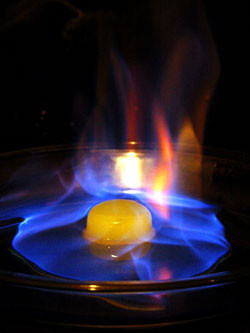
The Experiment
We were overwhelmed with feedback to our original Jell-O shots experiment raising dozens of unanswered questions and new areas of research. Such as: What happens when you add unflavored gelatin to regular Jell-O shots? How much grain alcohol can you put in a Jell-O shot? And perhaps most importantly, What happens when you light a Jell-O shot on fire? We went back to the fridge, and in our next round of Jell-O experiments, found the answers to these questions, and many more that no one thought to ask.
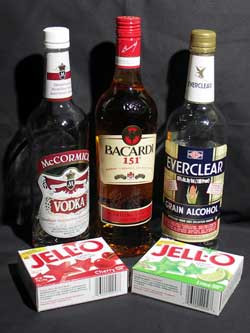
Life's necessities
Knox Your Blox Off
Our first Jell-O experiment was based on the classic Jell-O shot recipe, using only Jell-O brand gelatin and vodka. However, several readers told us that they fortified their Jell-O shots by adding unflavored Knox gelatin, and some suggested we try a prep technique called “blooming.”
We started where we left off in our last experiment, where we maxed out at 24 ounces of vodka in a single batch of sugar-free Jell-O shots. We decided to replicate this formula, but add a .25 oz. envelope of plain gelatin and increase the amount of vodka. We were able to keep the amount of water we added constant by using the blooming technique.
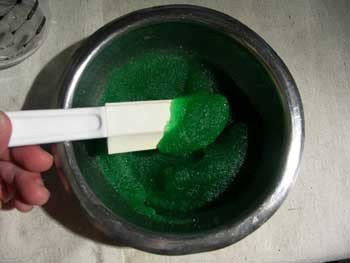
Bloomin' Jell-O
As with our original trial, we used 3 oz. of water in this batch. However, rather than mixing the gelatin into boiling water, as we did the first time, we added both the flavored and plain gelatin to cold water. We mixed thoroughly and let this grainy, mushy mixture sit for about half an hour so the gelatin could hydrate.
When the water was absorbed, the gelatin was still grainy and mushy, but now rubbery and semi-solid. The next step was to melt it in a hot water bath. We heated the bowl carefully in a pan of water until the gelatin mixture was dissolved, using a candy thermometer to make sure the temperature didn’t exceed 140 F. When the mixture was liquefied, we added it to 32 oz. of vodka, 8 oz more than we used previously.
Conclusions
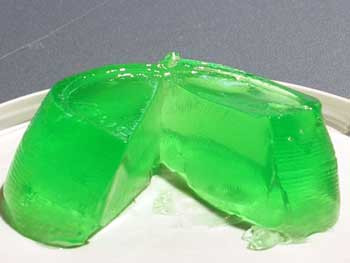
Firm, potent, but tasteless
The shots were clearer and more firmly gelled compared to the shots in the first experiment. The added unflavored gelatin definitely bolstered the gel factor and gave this batch a better texture while enabling us to squeeze in more vodka, boosting the ABV to 36.5 percent over the 35 percent we previously achieved. Not much of an increase, you say? Well, the vodka we’re using here is only 40 percent alcohol to begin with. If we put 64 oz. into this recipe, that would still yield only 38 percent ABV, and it would taste even worse than this batch. Although the Knox allowed us to add more booze, neither one of those did anything for the shots’ taste – they were flavorless and not sweet enough.
More Bang for the Shot
In our quest for the ultimate Jell-O shot, it became clear that cheap vodka would get us only so far. So we took the advice of many other readers and switched to cheap grain alcohol – Everclear, which is 190 proof, or 95 percent ABV. For the benefit of those who live in states that don’t sell 190 proof alcohol (or those who have too much class to buy it), we also tested out some Bacardi 151 (75.5 percent ABV).
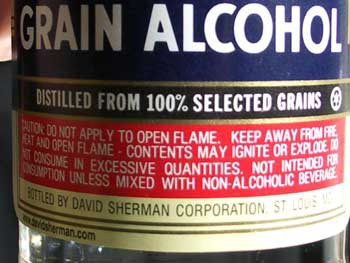
A charming and delicate liqueur
First, let us note that caution must be exercised when making (or more accurately, consuming) Jell-O shots made with Everclear. This liquor is so potent it carries a warning label telling you not to drink it straight. When you taste it, you’ll understand, because it tastes like rubbing alcohol. But also, you have to remember, it is nearly pure ethanol, and potentially deadly for that reason. No one should make Jell-O shots with straight Everclear because (1) they will taste vile and (b) someone could get killed. Fortunately, this is impossible anyway. Our first experiment using the Everclear had an unexpected result that demonstrates why.
We tried to go all out and add a cup (8 oz.) of straight Everclear to regular Jell-O dissolved in 4 oz. of hot water. To our surprise, as we poured in the liquor, the mixture turned murky, and strands of an egg-like substance formed. As we stirred, the goo massed around the spatula. Eventually we pulled out what looked like a wad of chewed bubble gum. The alcohol solution was so strong that it denatured the proteins in the gelatin! We poured the remaining mixture into serving cups to see if it would gel up anyway. The gelatin had enough protein remaining in it to set halfway. The result looked like a raw egg, with a semisolid blob floating in liquid.
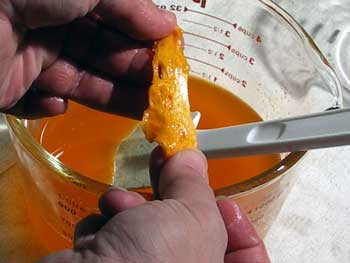
Don't swallow your gum
To demonstrate this process even more dramatically, we attempted to make a “pure” Jell-O shot – just gelatin, just alcohol, with a minimum of water. We mixed a dissolved envelope of plain, unflavored Knox gelatin with 8 oz. of Everclear. We added 2 oz. of water to the gelatin and used the “blooming” method, hydrating and then melting it. When we poured the alcohol into the liquefied gelatin, again the proteins coagulated into a white gooey mess (remind you of anything?). Given that gelatin is basically glue made from rendered cattle bones and skin, to which we were adding the equivalent of paint thinner, the results were predictably disgusting. In fact, just the thought of it may put you off Jell-O shots altogether. Coincidentally, alcohol is also used in DNA extraction in a similar manner to extract the DNA from a solution.
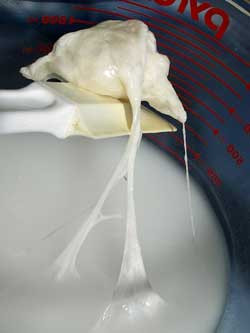
Synthetic spooge
Obviously, we had to add a bit more water to the mixture to dilute the Everclear. We made a batch with sugar-free lemon Jell-O, dissolving the gelatin in 3 oz. hot water and diluting the 8 oz. of Everclear with 4 oz. of cold water. With an ABV of 50.6 percent, the resulting shots were scarcely palatable and had a noticeable burn going down. We upped the ante with a batch using regular orange Jell-O dissolved in 4 oz. hot water, adding only 2 oz. of cold water to dilute the Everclear. This resulted in an ABV of 54 percent, and although the burning was nearly unbearable, the orange Jell-O tasted a bit better. These shots gelled a little softer and were a little clouded, but adding an envelope of Knox would probably firm them up. However, if Everclear is used, it will still need to be diluted by some water to prevent it from destroying the gelatin.
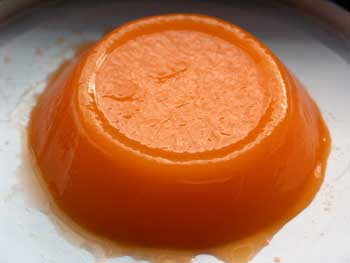
Harmless looking but deadly
For kicks, we also tried substituting Everclear in the “classic” Jell-O shot recipe, which uses one package Jell-O, 8 oz. hot water, 3 oz. cold water, and 5 oz. liquor. This batch yielded some nice, clear, firmly textured shots that tasted strongly of alcohol but were still palatable. Their ABV was around 30 percent, compared to the 12.5 percent you get when using regular vodka.
We also mixed up a batch using regular Jell-O, 4 oz. of hot water, and 8 oz. of Bacardi 151. These had an ABV of 51.6 percent and an overwhelming rum flavor that didn’t mix well with the Jell-O flavor. Since we were primarily interested in the physical properties of the gelatin, we’ll leave it to someone else to come up with a better tasting recipe.
Conclusions
It is impossible to make a Jell-O shot using Everclear and Jell-O alone, because the 95 percent alcohol solution destroys the gelatin. And it’s just as well. You can use Everclear to make a Jell-O shot with over 50 percent ABV, but you probably wouldn’t want to because it tastes terrible. You can use the standard Jell-O shot recipe to more than double the alcohol content compared to vodka, and the results are palatable. Diluting the Everclear and using it to make Jell-O shots is pointless because instead of having really strong, really bad alcohol, you’ll just have really bad, watered down alcohol. You’re better off using regular vodka, or maybe fortifying your Jell-O shots with a bit of Everclear for an extra kick. Bacardi 151 also works, but unless you have a really killer recipe, using it is a waste.
Out in a Blaze of Glory
Warning: High-proof liquor such as Everclear is extremely flammable and potentially explosive.
We now found ourselves with a bunch of alcohol-laden Jell-O shots that were nearly impossible to choke down. Our next task was to answer that burning question (no pun intended), What happens when you light a Jell-O shot on fire?
If the Jell-O shot is made with vodka, the answer apparently is: nothing much. We tried lighting some shots on fire after our last experiment and weren’t able to get them to take. This time, we coaxed a small blue flame from the vodka-filled Jell-O shot, only to have it sputter out after a few seconds.

More fun than lighting farts
The higher octane Jell-O, on the other hand, produced more spectacular results. When lit with a match, the shot caught fire and within seconds was engulfed in a bright blue blaze. As the alcohol burned, the heat melted the Jell-O, turning the whole thing into a flaming puddle of liquid. Fortunately we had the shots contained in a pan to keep them from oozing like a blazing oil slick. The flames shot up a good foot to foot and a half, and were quite hot. We noticed that the Everclear shots burned plain blue, while the shots made with Bacardi 151 had more yellow in the flames, perhaps because of the sugar or other impurities in the rum.
Although alcohol typically burns off quickly and a small alcohol fire can be blown out easily, the amount and strength of the alcohol kept it burning much longer, and the fire was too large to be extinguished by blowing on it. We doused ours with a box of baking soda kept close at hand. We very strongly discourage anyone from trying this at home, because it is dangerous. You definitely could set something or someone on fire.
Conclusions
We still haven’t determined whether it’s more dangerous to consume Everclear Jell-O shots or light them on fire. To be safe, we don’t recommend you do either.
Other experiments:
What is the Ultimate Jello-O Shot?
How Many Condoms Can You Wear at Once?
The Cheney Shotgun Experiment